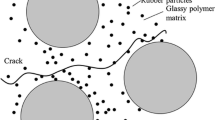Abstract
The effects of matrix ductility upon mechanisms of rubber toughening have been studied in a set of materials having identical rubber contents, but differing in matrix composition. The materials were made by solution blending 50% of HIPS (high-impact polystyrene) with polystyrene and PPO®† poly-(2, 6-dimethyl-1, 4-phenylene oxide) in varying proportions. Crazing was studied quantitatively by measuring volume changes during creep. Analysis showed that in blends of HIPS with polystyrene, crazing is the only significant mechanism of tensile creep, whereas in blends containing polyphenylene oxide, shearing mechanisms are also important, and the contribution of crazing to creep deformation can be as low as 30%, depending upon matrix composition. Scanning electron microscopy showed that both crazes and shear bands were present in strained HIPS/PPO blends. Shear band formation appears to be responsible for the increased fracture resistance of blends containing a high proportion of polyphenylene oxide. A theory of toughening is proposed for these blends.
Similar content being viewed by others
References
C. B. Bucknall andD. Clayton,Nature (Phys. Sci.) 231 (1971) 107.
Idem, J. Mater. Sci. 7 (1972) 202.
B. Maxwell andL. F. Rahm,Ind. Eng. Chem. 41 (1949) 1988.
R. P. Kambour,J. Polymer Sci. A2 (1964) 4159.
C. B. Bucknall andR. R. Smith,Polymer 6 (1965) 437.
J. Stoetling, F. E. Karasz, andW. J. McKnight,Polymer Eng. Sci. 10 (1970) 133.
H. E. Bair,ibid 10 (1970) 247.
A. R. Schultz andB. M. Gendron,J. Appl. Polymer Sci. 16 (1972) 461.
R. P. Kambour andR. R. Russell,Polymer 12 (1971) 237.
K. Kato,J. Electron Microscopy 14 (1965) 220.
M. W. Darlington andD. W. Saunders,J. Physics E3 (1970) 511.
S. Turner,Trans. J. Plast. Inst. 31 (1963) 60.
M. Matsuo, C. Nozaki, andY. Jyo,Polymer Eng. Sci. 9 (1969) 206.
C. B. Bucknall, I. C. Drinkwater, andW. E. Keast,Polymer 13 (1972) 115.
L. J. Broutman andF. J. McGarry,J. Appl. Polymer Sci. 9 (1965) 589, 609.
E. F. T. White, B. M. Murphy, andR. N. Haward,Polymer Letters 7 (1969) 157.
Author information
Authors and Affiliations
Rights and permissions
About this article
Cite this article
Bucknall, C.B., Clayton, D. & Keast, W.E. Rubber-toughening of plastics. J Mater Sci 7, 1443–1453 (1972). https://doi.org/10.1007/BF00574936
Received:
Accepted:
Issue Date:
DOI: https://doi.org/10.1007/BF00574936




